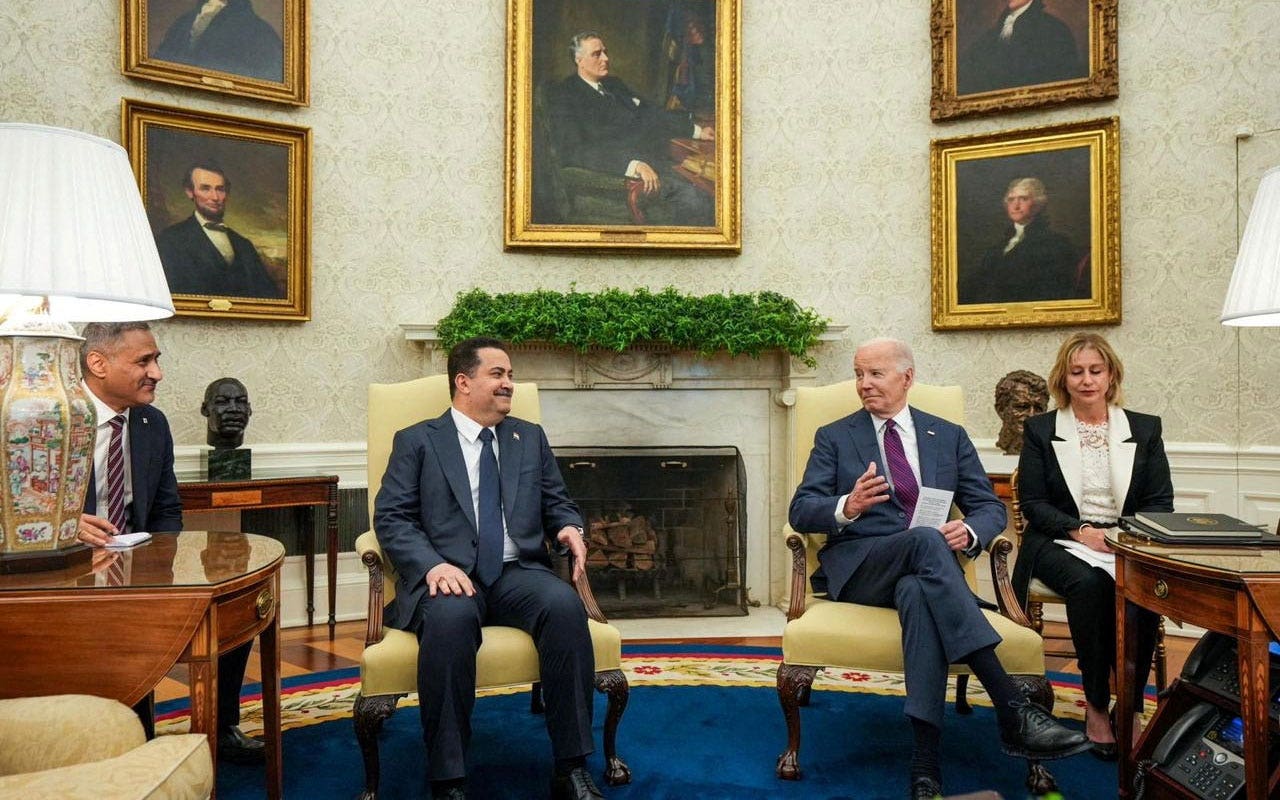Lifestyle
Priced Out of the City, They Bought a Tiny Suburban Home. Now What?

Much has been written about “good enough” marriages, but what of “good enough” houses in “I guess we have to live somewhere” neighborhoods?
This is the story of a family who began with low expectations and then fell in love.
In 2016, Amanda and Alain de Beaufort were renting an apartment with a garden in Sunset Park, Brooklyn, where they had access to a new school with a Spanish/English program for their two children. (Mr. de Beaufort, 49, is from Colombia.) The family had achieved urban-suburban balance in a community they treasured. They were happy.
Then one day, their landlord sold the building for cash and gave them a month to pack up and move out.
“OK, we’ll just buy something in Sunset Park,” Ms. de Beaufort, 46, recalled saying, before making the cruel discovery that no affordable properties remained in the neighborhood. The couple cast their eyes on nearby Bay Ridge, Brooklyn. They flirted with Westchester County.
They did not consider New Jersey. “It wasn’t cool,” Ms. de Beaufort said.
Soon, she was sleeping on the sofas of friends as she house-hunted, while her husband and children bunked at her parents’ home in New Hampshire. In this precarious state, they succumbed to a campaign waged by a friend in Maplewood, N.J., who described that township, about 20 miles west of New York City, as a cross-Hudson-River extension of Brooklyn. (At least one newspaper article has made the same comparison.)
The couple bought a small house on a pretty, tree-lined street in Maplewood and declared it their not-forever home.
If they were going to move to the suburbs, they thought, they might at least enjoy ample space. But the 1923 colonial was roughly 900 square feet, with three tiny bedrooms and a sliver of backyard — smaller than New York City apartments they had occupied. Furthermore, its previous owner, whom Ms. de Beaufort described as “a DIY guy,” had a fondness for murky colors and copious, awkwardly placed storage nooks.
“It was endearing what he did,” she said. “But it wasn’t done right.”
Ms. de Beaufort, who is the director of communications for the architect Daniel Libeskind, could sense the virtues lurking beneath the most regrettable surfaces. Although the house was not overflowing with suburban amenities, its small yard and windowed basement were useful for her side hustle as a botanical dyer. (She imprints items like socks and tea towels with blossoms, and she and Mr. de Beaufort sell them through a company called ADB Botanical Color.)
More to the point, the house had been listed for $265,000 — $100,000 below the family’s budget — so they could afford to give it a face-lift.
Ms. de Beaufort began in the kitchen, which had damaged black-tile counters and jury-rigged wiring that looked ominous. She replaced the misaligned Home Depot cabinets with custom Shaker-style ones, maple plywood for the top set and painted wood for the bottom. (The paint color is the Farrow & Ball pink notoriously called Dead Salmon.) Beneath the wood-patterned linoleum flooring, she found and refinished actual wood. For the new counters, she went with a quartz that resembled terrazzo. By the time she finished, she had spent about $36,000.
In the living room and primary bedroom, she repainted the drab walls white to make the spaces look bigger.
But what to do with the children’s quarters, which were effectively shoe boxes, subdivided from what had once been a single, small room?
As the lockdown made this question more urgent, Ms. de Beaufort consulted a local interior designer named Hollie Velten. Ms. Velten is schooled in the travails of urban expats. Many of her clients are former renters who “are a little overwhelmed with a new acquisition of real estate,” the designer said. “Or they are suddenly second-guessing their decision to move to the boring suburbs and want to make it their own.”
She worked closely with Henry, now 13, and Adela, now 11, on picking the colors and features for their miniature domains.
Henry’s room — so small that he had to climb over the bed to get into it; so small that the tax assessor declined to count it as a bedroom — became a pumpkin-orange cabin with lemon molding and accent patches of sage.
Partly inspired by the opening sequence of “An American in Paris,” where Gene Kelly rearranges furniture and pulls objects out of closets simply to sit down to breakfast in his Left Bank studio, Ms. Velten installed low-key plywood bookcases and shelves that provided storage without calling attention to the crying need for it. On one wall, plywood panels radiate warmth on their own, but also open to reveal a closet and a study nook.
The previous owner had broken through Henry’s ceiling to create overhead storage. Ms. Velten replaced the fixed ladder with a library model that could move aside, allowing access to the closet. Climbing the ladder, one finds a compact loft with a window, where Henry likes to lounge and listen to his collection of vinyl LPs.
“They’re going to be, like, smoking weed up there at some point,” Ms. de Beaufort said.
In Adela’s shoe box, Ms. Velten turned a niche that was formerly a play space into a sleeping area painted the color of purple cauliflower. The niche and surrounding areas include cubbies and inconspicuous storage drawers. In between shelves are flashes of wallpaper from the British company Common Room, patterned with snakes, moons, oysters, coral and clover.
Adela’s “whole idea was to have this mermaid-cottage vibe here,” Ms. de Beaufort said. But she is grateful that her interpretation was sophisticated enough to allow the room to be used for guests once she grows up and leaves home.
Because the couple are now planning to hang around.
They are enjoying the renovated bathroom that Ms. Velten redid with square, sage-green floor tiles and chrome fixtures for an apothecary look. (The total cost for renovating the bathroom and remaking the children’s bedrooms: about $75,000.) They have planted perennials — including indigo — in the backyard for Ms. de Beaufort’s botanical dyeing adventures. And they love Maplewood.
Now that they have put so much thought into the house, “it’s like it’s been customized,” Ms. de Beaufort said. “I don’t want to get rid of it and start again.”
Living Small is a biweekly column exploring what it takes to lead a simpler, more sustainable or more compact life.
For weekly email updates on residential real estate news, sign up here.

Lifestyle
50 years ago, 'Come and Get Your Love' put Native culture on the bandstand

Founded by brothers Pat and Lolly Vegas, Redbone scored a Top 5 hit in 1974 with “Come and Get Your Love,” launching their Indigenous style and influences into the pop conversation.
Sandy Speiser/Courtesy of Sony Legacy
hide caption
toggle caption
Sandy Speiser/Courtesy of Sony Legacy

Founded by brothers Pat and Lolly Vegas, Redbone scored a Top 5 hit in 1974 with “Come and Get Your Love,” launching their Indigenous style and influences into the pop conversation.
Sandy Speiser/Courtesy of Sony Legacy
Fifty years ago this month, President Richard Nixon was facing impeachment. Hank Aaron broke Babe Ruth’s home run record. Leaders of the American Indian Movement were on trial after the armed standoff at Wounded Knee. And the song “Come and Get Your Love” was one of the biggest hits on the radio.
This soulful pop tune by the band Redbone was, in some ways, related to what was going on politically. It became the first song by an all-Native and Mexican American band to crack the Billboard Top 10, peaking at No. 5 on April 13, 1974.
Since its release on Redbone’s 1973 album Wovoka, “Come and Get Your Love” has been used in commercials, on TV shows including the Netflix series F Is for Family and in movies. The song captured a new generation of fans in 2014, when actor Chris Pratt danced to it in the opening scene of Marvel’s Guardians of the Galaxy.
Musician Stevie Salas remembers first hearing “Come and Get Your Love” as a sixth grader in Oceanside, Calif., where it came on during a school dance. Salas, who is Apache, has played guitar with musicians such as Rod Stewart, Bootsy Collins, Mick Jagger and Justin Timberlake. He’s also an executive producer on a documentary about Native musicians called Rumble: Indians Who Rocked The World. But back in sixth grade, he had no idea the musicians behind “Come and Get Your Love” were Native and Mexican American — until he saw them on TV.
“Redbone came on and they were all dressed like Natives. I mean, that was just mind-blowing,” Salas recalls. “But at the same time, you’d see people dressed like that, you know, on Halloween. So I don’t know, are they real Indians? It’s like that. But they sure look cool.”
Redbone added a traditional Native intro to “Come And Get Your Love” when the band performed it on The Midnight Special in 1974.
The Midnight Special
YouTube
The pompadour years
Redbone’s founders had always cultivated a striking look, though the decision to showcase their Native culture onstage took time.
Brothers Pat and Lolly Vasquez grew up in Fresno, Calif. According to Pat’s memoir, their mother was Shoshone, while their father had both Mexican and Native roots including Yaqui, Papago and Navajo. Their maternal grandfather was a musician from Texarkana who played Cajun and Mariachi music, and who taught Pat and Lolly to play guitar. When the brothers started playing as a duo, Pat switched to bass.
In the late 1950s, the two started playing gigs in and around Los Angeles, from sock hops to family picnics. After a music industry veteran recommended they change their surname to appeal to white talent bookers, they put a spin on their stepfather’s name, De La Vega, rebranding as Pat & Lolly Vegas. Their stage style in this era was suits and slicked-back pompadours: “We used to get our hair done and all this stuff. We had a real straight look,” remembers Pat Vegas, who, at 83, is the last surviving original member of Redbone. (Lolly died in 2010.)
In addition to the club gigs, the Vegas brothers were session musicians and songwriters. They appeared in the 1967 beach comedy It’s a Bikini World, and teamed up with other musicians to record surf music under the name The Avantis.
Before they formed Redbone, brothers Pat and Lolly Vegas were a popular duo that played in Los Angeles clubs, and on the TV show Shindig! in 1964.
YouTube
The Vegas brothers were successful making music that appealed to the mainstream. But they were also inspired by the Civil Rights movement, and by Native activists who were calling out the poverty on reservations, broken treaties and other injustices. “Our friends were going out there and marching and protesting,” Pat Vegas says, explaining that as entertainers, they wanted to show the world a more accurate depiction of Native people. “Because it was being overlooked. They saw us in Western movies being chased by the cowboys, and we didn’t want to be a part of that. We wanted to show that we had grown and we were part of the future.”
Pat & Lolly Vegas eventually ditched the pompadours, and set out to form a band of all Native and Mexican American players. They were joined by rhythm guitarist Tony Bellamy, who was of Mexican and Yaqui descent, and drummer Pete DePoe, who was Cheyenne. They grew their hair long, and began performing in Native dress on stage. The choice wasn’t just a reaction to the politics of the moment, Vegas says — it was who they were.
“My mom was proud of her Native American roots, and I was too,” he says. “So automatically, we knew what we wanted, and the sound came out that way, and it was beautiful. I just wanted to be real.”
A sound both political and ‘all about love’
The new group called itself Redbone, a slang term that some might find offensive, though the members said they used it to mean mixed race. The band signed with Epic Records and set about creating its own sound, what Vegas has called “Native American swamp rock.”
In 1973, a group of Native activists occupied the town of Wounded Knee in South Dakota — the same site where, 83 years earlier, hundreds of Lakota had been massacred by U.S. soldiers. Pat Vegas says he “felt the struggle,” and wanted to contribute.
YouTube
For Redbone’s album Wovoka, Vegas wrote the song “We Were All Wounded at Wounded Knee.” The song became a hit in Europe, but CBS refused to release it in the U.S., fearing it was too controversial. Vegas has said that he understood the company’s reasoning and that he wasn’t angry (though some scholars, like University of Idaho professor Jan Johnson, have called it a missed opportunity and an example of “historical amnesia” around events that make us uncomfortable).
There was, however, another song on Wovoka that the label thought could be a hit. As Pat Vegas tells it, he and his brother worked on “Come and Get Your Love” late one night in Philadelphia, where they were performing a series of gigs. It was finished the next day.
In his memoir, Pat claims that the song was co-written by the two of them, but that Lolly claimed sole credit for it with the label. He writes that while he was “appalled” and “furious” with his brother, he chose to stay silent, believing that raising a stink would hurt Redbone’s reputation. When I asked how the disagreement affected their relationship, he says, “We got over it.”
‘A sound that was so inclusive’
“Come and Get Your Love” spent 18 weeks in the Top 40 and was the fourth most popular song of Billboard‘s Hot 100 for 1974. In the years since, its presence has continued to echo through pop: The Eurodance group Real McCoy released a club-ready cover, Cyndi Lauper updated her own “Girls Just Want to Have Fun” by mashing it up with Redbone’s hit —and, in 2020, Sony’s Legacy Recordings released the song’s first official music video, an animated short by Native artist Brent Learned and producer and director Juan E Bedolla.

Taboo Nawasha of the Black Eyed Peas says Redbone “kicked down the door” for Native musicians like himself.
Taboo Nawasha
hide caption
toggle caption
Taboo Nawasha
In the 1970s, the song’s massive popularity gave the members of Redbone a platform to show pride in their Native heritage. Rapper Taboo Nawasha of chart toppers the Black Eyed Peas says that’s what he, another musician of Native and Mexican ancestry, strives for in his music.
“With a sound that was so inclusive, [“Come and Get Your Love”] was for everyone to come and rock out,” Nawasha says. “Redbone kicked down the door and said, ‘We’re proud to be Native, check us out. We’re here, we’re alive and we’re going to bring that great energy and that good medicine to the world.’ “
Reflecting on the song 50 years later, Pat Vegas says a lot of people think “Come and Get Your Love” is about romance. They’re not entirely wrong — but there’s more to it than that.
“It’s love all around, in every facet and every part of your being, you know?” he says. “And that’s the message: What’s the matter with your mind and your sign? Come and get your love. In other words, where you come from and who you are doesn’t matter as much as what you believe, and what you feel.”
The audio version of this story was edited by Rose Friedman and produced by Isabella Gomez Sarmiento. The digital version was edited by Daoud Tyler-Ameen.
Lifestyle
This iconic wildflower spot can be dazzling. Is it worth the 150-mile trek from L.A. this year?
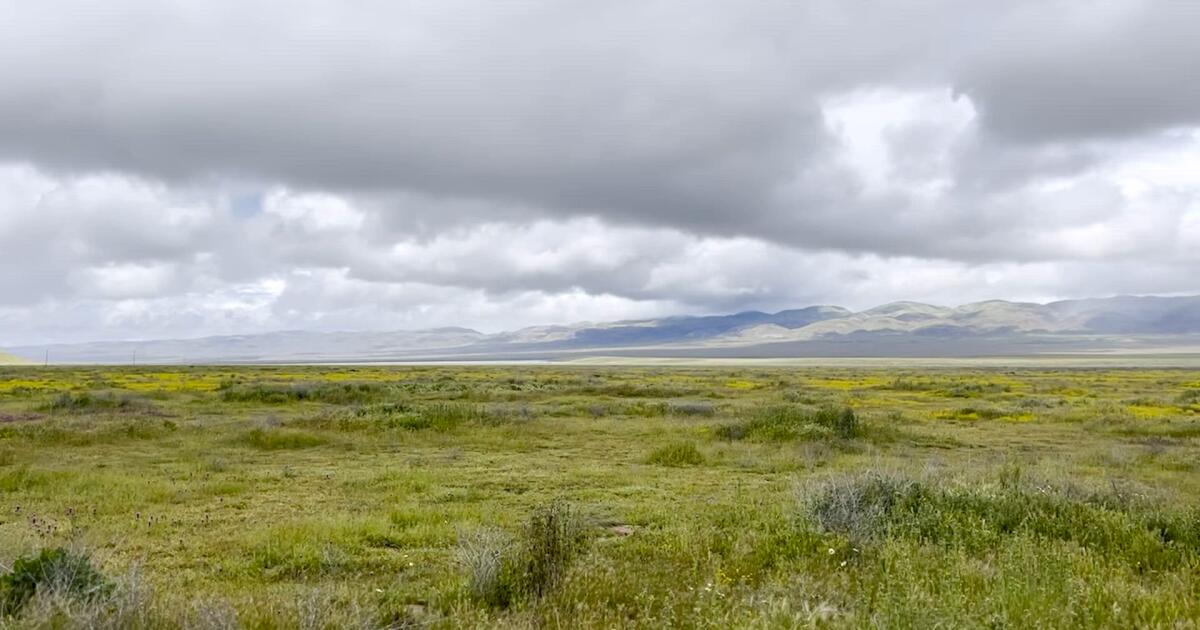
Carrizo Plain National Monument in eastern San Luis Obispo County is one of California’s most iconic wildflower viewing areas, but is this year’s display worth the 150-mile drive from L.A.?
If you’re looking for blankets of bright color covering the hills, the answer is no.
But if you want a beautiful outing with boundless sky, close encounters with birds, Indigenous and geologic history and undulating waves of grass punctuated by splotches of gold, violet and orange, then definitely yes — but wait a good week or more for the muddy roads to become passable again.
In early March, a friend and I planned our visit for April 14, largely because the rainy season is typically over by the end of March, peak bloom is typically in early April, and given this spring’s cool temperatures, we figured the weather would have warmed by then to encourage a good display. But the first two weeks of April brought plenty of chilly showers to much of Central and Southern California, and during our visit, the temperatures hovered in the mid-50s, and the rain waxed and waned between hopeful moments of blue sky followed by black clouds and water falling in curtains.
The best wildflower display was in a large photo from 2019 of goldfields carpeting a valley hanging in the bathroom of the Cuyama Buckhorn restaurant in New Cuyama.
(Jeanette Marantos / Los Angeles Times)
Truth be told, the best wildflower display we saw during our visit was a 2019 photograph in the restroom of the Cuyama Buckhorn restaurant in New Cuyama — a stunning view of California goldfields (Lasthenia californica) growing so vast in the Carrizo Plain during a superbloom that they looked like a golden carpet stretching for miles.
Truth be told, the best wildflower display we saw during our visit was a 2019 photograph in the restroom of the Cuyama Buckhorn restaurant.
We did see swaths of goldfields during our soggy trip, along with armies of brown sodden tumbleweeds and pockets of other wildflowers, such as purple owl’s clover (Castilleja exserta), which are actually violet; yellow and white common tidy tips (Layia platyglossa); and (rarely) California poppy (Eschscholzia californica). But the most prominent color was the bright green of California’s hills after a rainy spring.
The tall grass was thick and ripply, like wind on water, and often erupted with birds that flew alongside our car and sometimes outpaced us because Soda Lake Road, the lone paved road, was pocked with gaping potholes and puddles of concerning depth.
A superbloom? Not then and probably not this year, according to the rangers at the Goodwin Education Center at Carrizo Plain. The sign behind the front counter told the story. The last three superbloom years — when wildflowers bloomed so densely that they formed quilts of color over the hills — were in 2017, 2019 and 2023, the rangers said, when the region’s rainfall from Oct. 1 to Sept. 30 had, respectively, been 12.29 inches, 16.31 inches and 15.32 inches. So far, the rainfall for 2024’s water year is less than 10 inches — including the unseasonable rain falling April 14 — and more rain this season is not expected.
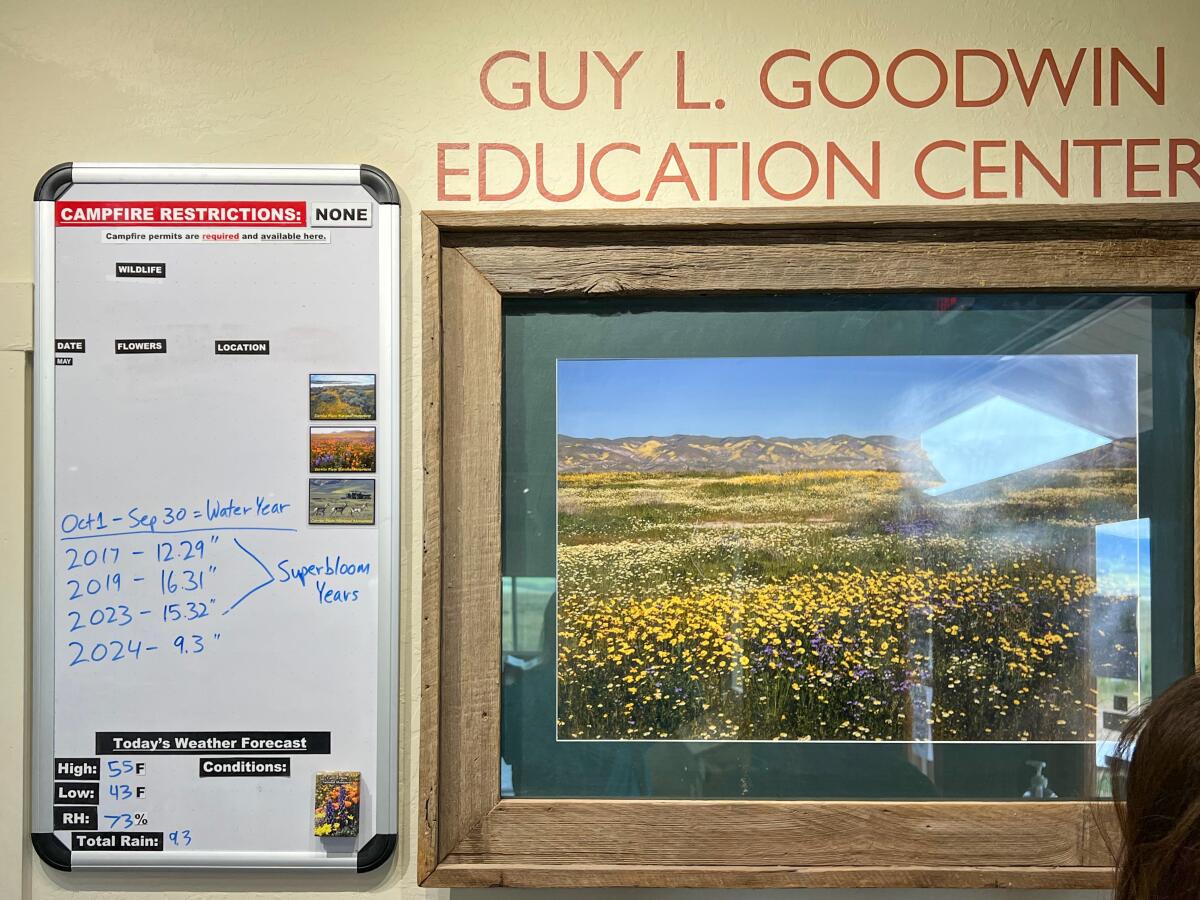
The sign in the Guy L. Goodwin Education Center shows that the Carrizo Plain’s rainfall this year has been less than in past years with “superblooms” that carpeted the hills.
(Jeanette Marantos / Los Angeles Times)
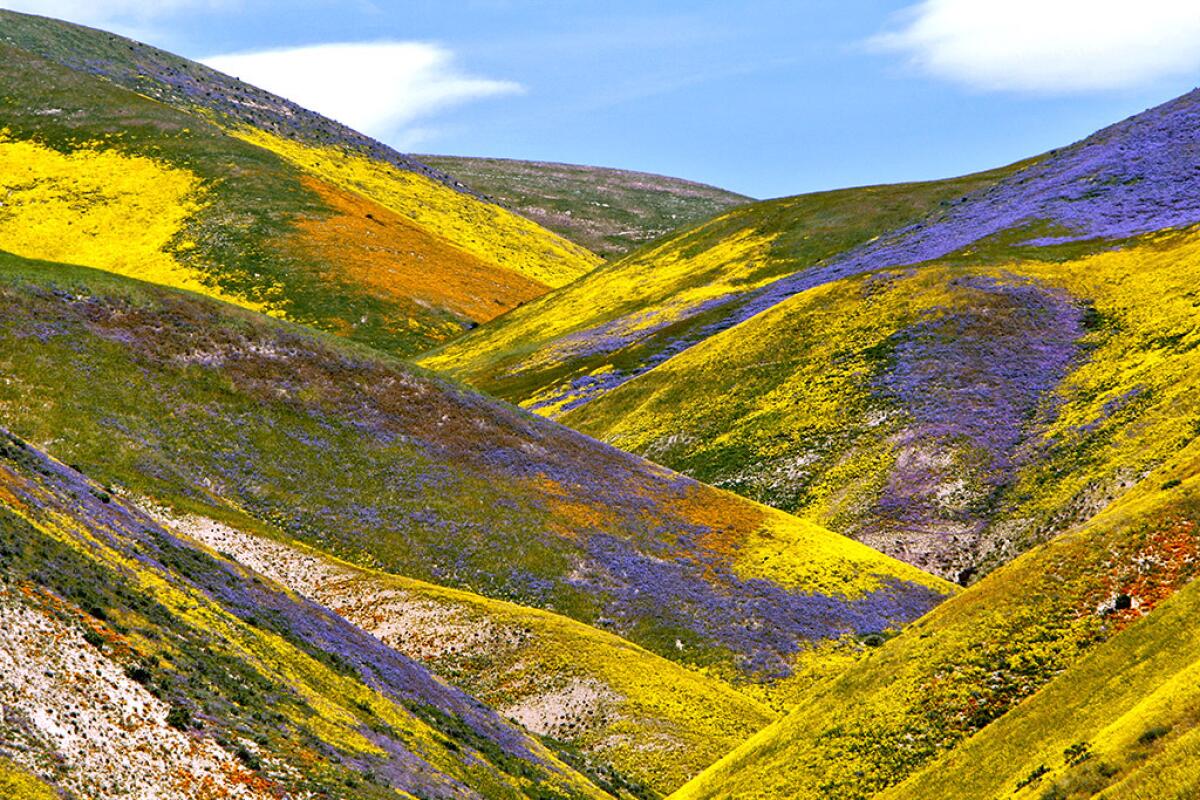
The Carrizo Plain superbloom on April 16, 2017.
(Raul Roa / Los Angeles Times)

Scenes of the Carrizo Plain on April 14, 2024 during a drive on the paved portion of Soda Lake Road in Carrizo Plain National Monument in San Luis Obispo County. These days, the plain consists primarily of grasses, with sporadic color.
(Jeanette Marantos / Los Angeles Times)
The Carrizo Plain stretches 50 miles between the Temblor and Caliente mountains, a grassy plain and drainage basin where Chumash, Yokuts and other Indigenous peoples hunted and traded before settlers tried their hand at dryland farming. There are a few campgrounds, trails and unpaved roads, but no services (such as gas, water, food and, usually, cell). The temperatures often exceed 100 degrees in the summer and dip down to freezing during the winter, according to the brochure. All but one of the roads, Soda Lake Road off Highway 58, are unpaved, and even Soda Lake Road becomes an unpaved, rutted road five miles south of the Goodwin Education Center, which features restrooms and picnic tables, along with books, gifts and exhibits.
Besides birding, camping, hiking and wildflower peeping, you can walk along the San Andreas Fault on the Wallace Creek trail, wander on a platform trail along Soda Lake, which becomes a “dry, salt-encrusted basin during the dry season,” according to the brochure, and study the pictographs left by Native peoples on Painted Rock, which this time of year can be visited only with ranger guides on Saturdays (reservations required).
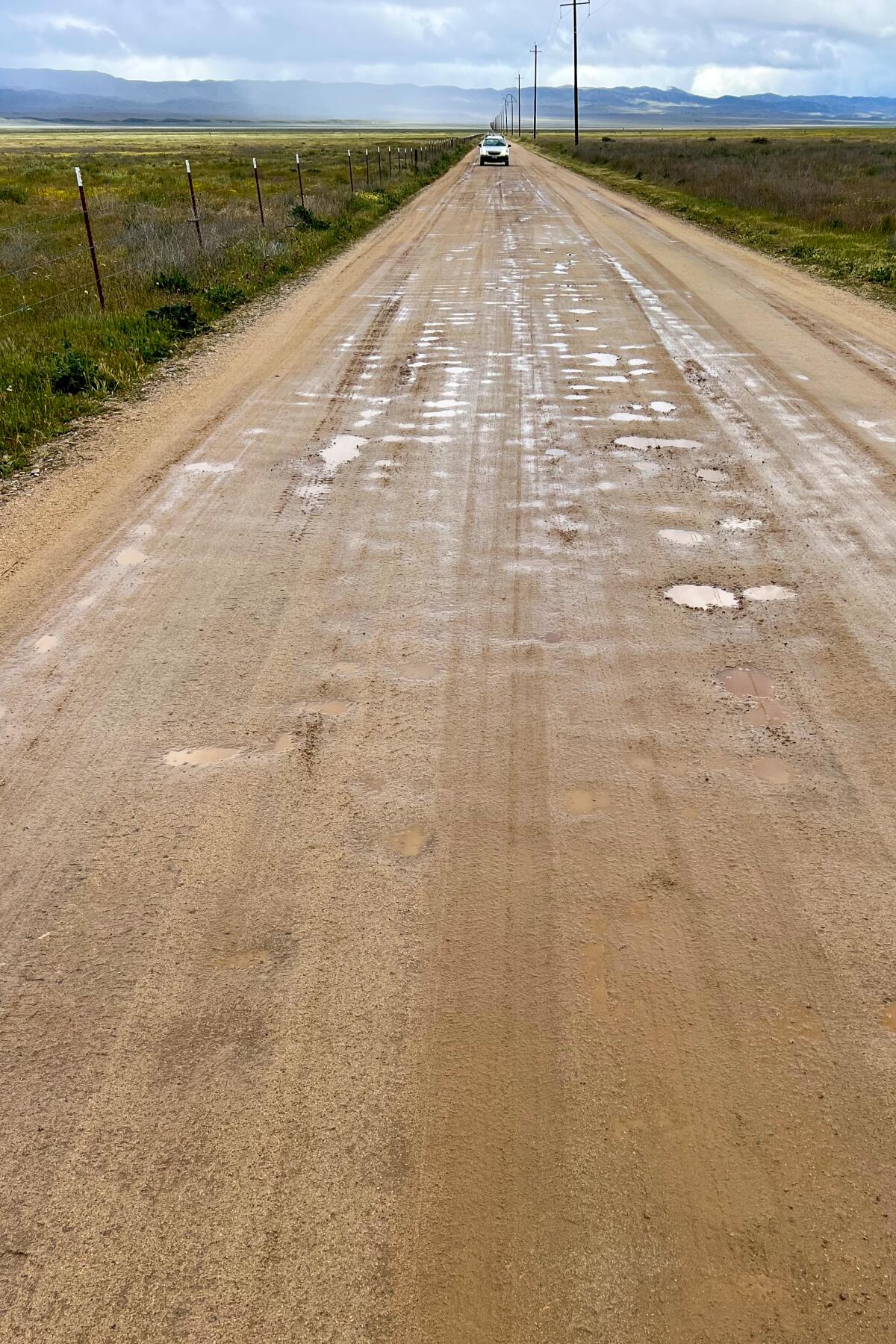
It poured rain much of the day, and the nonpaved roads were mostly impassable, except for a short road to the visitor center.
(Jeanette Marantos / Los Angeles Times)
But on Sunday, we couldn’t do any of that because the muddy, unpaved roads were so impassable that even tow trucks were getting stuck, according to rangers. Every few minutes, someone came into the center and asked the same question — is it safe to keep driving south on Soda Lake Road once the pavement ends? And every time, the rangers patiently answered that they definitely wouldn’t recommend any of the unpaved roads for two-wheel-drive cars, or even four-wheel-drive SUVs, unless they had high clearance, nerves of steel and enough money to pay for a tow truck.
The few that braved the back roads drove brawny vehicles that looked like they’d been sloppily dipped into chocolate. As my friend and I wavered about what to do, we spoke with two people who had made the drive. They had a kind of hysterical look and emphatically told us not to try, even though my Toyota Highlander SUV has four-wheel drive. “I can’t believe we made it,” said one wide-eyed woman in a large pickup with mud caked halfway up its windshield. “You’d never get through.”
A few hearty souls were walking in the rain on the platform trail along Soda Lake, but the tiny parking area had so many muddy ruts and puddles that we decided to avoid that too, lest we get stuck. Instead, I grumpily drove back north to California 58 — even though I hate backtracking — and headed east. Our mood quickly improved along this spectacular winding drive through what looked like the verdant, tree-dappled Shire in the Lord of the Rings.
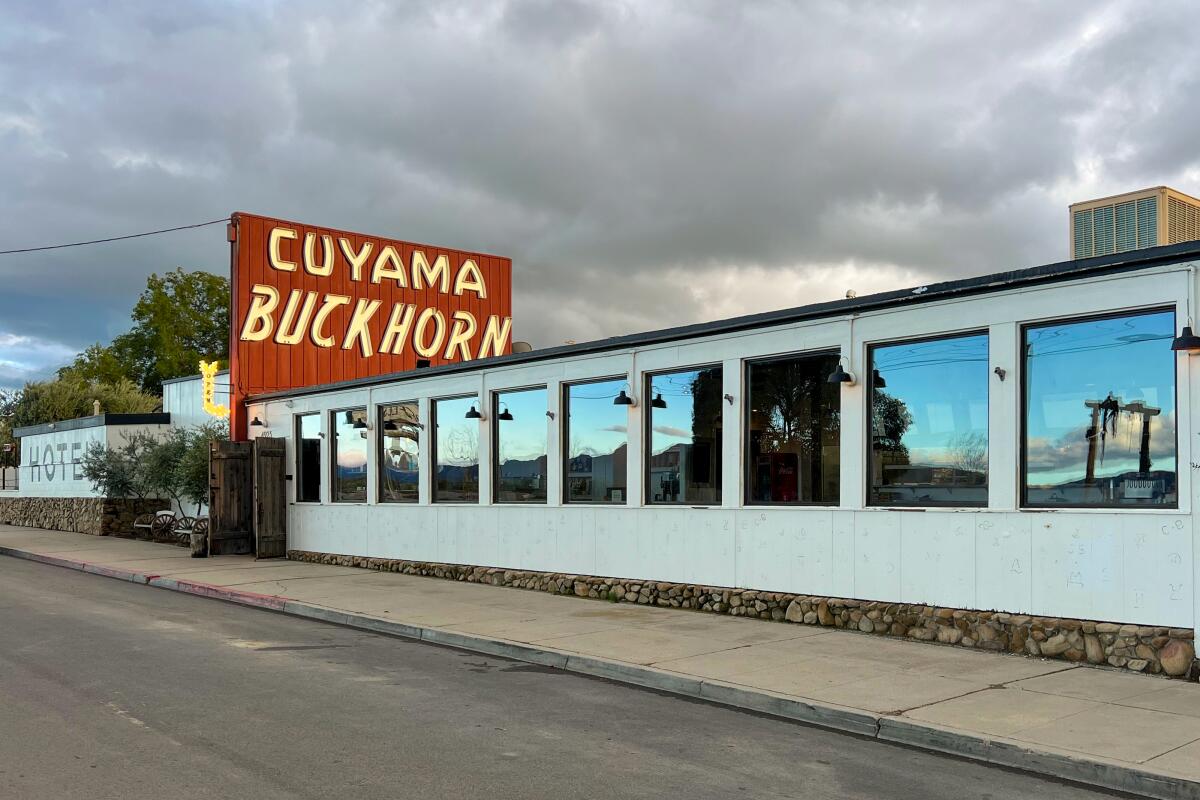
The Cuyama Buckhorn restaurant in New Cuyama. Order the smoked oyster mushroom tacos and check out the bathroom for a gorgeous 2019 superbloom photo.
(Jeanette Marantos / Los Angeles Times)
After our lovely drive south on 58, we turned west on California 33 near McKittrick, and within a few miles entered a hellscape of bobbing oil pumps and acres of power poles and wires between Derby Acres and Taft. Our destination was New Cuyama for a late lunch-early dinner at the Cuyama Buckhorn restaurant on California 166, which runs along the western border of the Carrizo Plain. I heartily recommend this restaurant, which despite its tiny town locale has a sophisticated, upscale bar, wine list and menu (the smoked oyster mushroom tacos with tender blue-corn tortillas — made at the restaurant — are to die for), along with a remodeled hotel.
And when we were done, the clouds were parting, luckily, because our final leg took us west through Los Padres National Forest on California 33, a scenic but winding road where earlier rain had washed out several spots, so we had to stop frequently to wait for a green light to travel along single lanes. The going was beautiful but slow and a little hair-raising as day turned to night.
Lifestyle
5 takeaways from Salman Rushdie's new memoir 'Knife'

Author Salman Rushdie at the annual gala of PEN America on May 18, 2023.
Ted Shaffrey/AP
hide caption
toggle caption
Ted Shaffrey/AP

Author Salman Rushdie at the annual gala of PEN America on May 18, 2023.
Ted Shaffrey/AP
On August 12, 2022, famed author Salman Rushdie was stabbed. He was on stage at the Chautauqua Institution in western New York, about to give a talk “about the importance of keeping writers safe from harm,” Rushdie writes in his new memoir, Knife: Meditations After an Attempted Murder.
Rushdie, the 76-year-old writer of The Satanic Verses, Midnight’s Children, Victory City, and more, survived the attack. But not without some lasting scars, including being blind in one eye. Since the attack, he’s done a handful of interviews here and there, but he’s kept mostly to himself. In Knife, he details everything that’s been going on in his life and in his head since the attack. He talks about the recovery process, the support he received from loved ones, and his feelings about his alleged attacker, Hadi Matar.


Matar is in custody at Chautauqua County Jail, being charged with second-degree attempted murder and second-degree assault. The judge in his case actually postponed Matar’s trial after Rushdie announced his memoir, in order to give Matar’s lawyers an opportunity to see what’s inside the book.
The book is out Tuesday. Here’s what you can expect from it:
1. Rushdie has no interest in re-litigating The Satanic Verses
Rushdie only makes a few mentions of his 1988 book that led the supreme leader of Iran at the time to call for Rushdie’s death. And, Rushdie notes in Knife, it wasn’t just the Muslim world criticizing Rushdie for writing the book. He calls out other names, including former U.S. President Jimmy Carter and the writers Roald Dahl and Germaine Greer. Besides that, Rushdie writes that he’s said everything he’s needed to say about Satanic Verses in his previous memoir, Joseph Anton.” If anyone’s looking for remorse, you can stop reading right here,” he writes in Knife. “My novels can take care of themselves.”
2. The book is about freedom of speech, particularly aimed at the left
Rushdie instead saves his argumentative energy to make an appeal for freedom of speech – an ideal, he believes, progressives and the left have left behind to their detriment. “This move away from First Amendment principles allowed that venerable piece of Constitution to be co-opted by the right,” he writes. Rushdie had a long background in free speech advocacy. He’s the former president of PEN America, the literary rights advocacy group, and co-founded that organization’s World Voices Festival. His first public appearance after being attacked was at a PEN Gala in his honor. And, if anything, the attack has only furthered his positions. “Art is not a luxury. It stands at the essence of our humanity, and it asks for no special protection except the right to exist,” he writes.
3. It’s also a book about marriage
In 2021, Rushdie quietly married the poet and novelist Rachel Eliza Griffiths. Rushdie is tender when he writes about the early days of their relationship, saying he was not looking for romance. “And then it came up behind me and whacked me behind the ear and I was powerless to resist.”
It’s Griffiths who helps Rushdie through the many doctor visits, physical therapy appointments, sleepless nights, mystery ailments and piling bills (a sub-takeaway could be, not even world-famous authors can avoid surprise medical bills), all while tending to her own writing career. There are tough moments that they have to go through together in the book, but there are also regular moments that could be scenes from any other marriage.
4. He tries to understand his attacker
Rushdie never refers to Matar by name in the book. And he maintains a certain distance from him. There’s a quick instance in the memoir where Rushdie toys with the idea of reaching out to Matar, but he quickly decides that’s a bad idea. Instead, Rushdie chooses a different route to understanding Matar that we won’t spoil here. But it is an exercise in deep empathy – one that seems to help Rushdie find at least a little bit of closure.
5. There’s a possible documentary on the way.
Early on in the book, Rushdie and Griffiths begin filming Rushdie’s thoughts. The plan seems to be to take all the footage and bring it to an experienced filmmaker, who can shape it into something. But there have been no announcements made on that front yet.
-

 News1 week ago
News1 week agoVideo: Election Officials Continue To Face Violent Threats
-
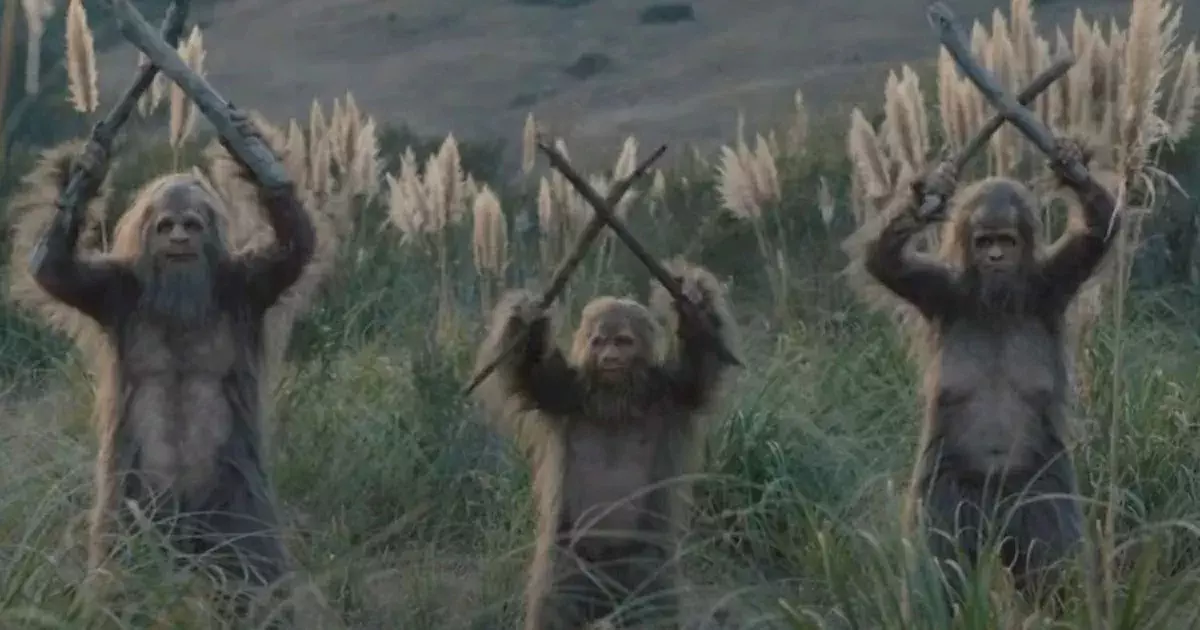
 Movie Reviews1 week ago
Movie Reviews1 week agoSasquatch Sunset (2024) – Movie Review
-

 Science1 week ago
Science1 week agoThe Eclipse Across North America
-
Fitness1 week ago
This exercise has a huge effect on our health and longevity, but many of us ignore it
-

 Uncategorized1 week ago
Uncategorized1 week agoANRABESS Women’s Casual Loose Sleeveless Jumpsuits Adjustbale Spaghetti Strap V Neck Harem Long Pants Overalls with Pockets
-

 Finance1 week ago
Finance1 week agoSponsored: Six Ways to Use Robinhood for Investing, Retirement Planning and More
-

 Crypto1 week ago
Crypto1 week agoAnalyzing the Environmental Impact of Cryptocurrency Mining
-

 Politics1 week ago
Politics1 week agoVideo: Biden Announces New Plan for Student Debt Relief










